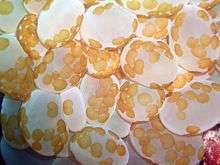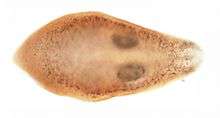Acoela
Acoela, or the acoels, is an order of small and simple invertebrates in the subphylum Acoelomorpha of phylum Xenacoelomorpha, a deep branching bilaterian group of animals, which resemble flatworms. Historically they were treated as an order of turbellarian flatworms.[1][2]
| Acoela | |
|---|---|
 | |
| Many flatworm-like, orange individuals of the Waminoa acoel on a Plerogyra coral (whitish bubbles) | |
| Scientific classification | |
| Kingdom: | Animalia |
| Phylum: | Xenacoelomorpha |
| Subphylum: | Acoelomorpha |
| Order: | Acoela Uljanin, 1870 |

The etymology of "acoel" is from the Ancient Greek words ἀ (a), the alpha privative, expressing negation or absence, and κοιλία (koilía), meaning "cavity".[3][4] This refers to the fact that acoels have a structure lacking a fluid-filled body cavity.
Description
Acoels are very small flattened worms, usually under 2 millimetres (0.079 in) in length, but some larger species, such as Symsagittifera roscoffensis, may reach up to 15 millimetres (0.59 in).[5]
They are found worldwide in marine and brackish waters, usually having a benthic lifestyle, although some species are epibionts.[6]
Members of the class Acoela lack a conventional gut, so that the mouth opens directly into the mesenchyme, i.e., the layer of tissue that fills the body.[7][8] Digestion is accomplished by means of a syncytium that forms a vacuole around ingested food. There are no epithelial cells lining the digestive vacuole, but there is sometimes a short pharynx leading from the mouth to the vacuole. All other bilateral animals (apart from tapeworms) have a gut lined with epithelial cells. As a result, the acoels appear to be solid-bodied.
As the basal lineage of bilateral animals, the Acoela provide interesting insights into early animal evolution and development.[9][10] The most thoroughly studied animal in this group is the species Isodiametra pulchra. Acoela used to be classified in the phylum Platyhelminthes. However, Acoela was separated from this phylum after molecular analyses showed that it had diverged before the three main bilaterian clades had formed.
Taxonomy
The following sub-taxa are recognised in the order Acoela:[11]
- Family Actinoposthiidae Hooge, 2001
- Family Antigonariidae Dörjes, 1968
- Family Antroposthiidae Faubel, 1976
- Family Diopisthoporidae Westblad, 1940
- Family Nadinidae Dörjes, 1968
- Family Paratomellidae Dörjes, 1966
- Family Taurididae Kostenko, 1989
- Suborder Bursalia Jondelius et al., 2011
- Infraorder Crucimusculata Jondelius et al., 2011
- Family Dakuidae Hooge, 2003
- Family Isodiametridae Hooge & Tyler, 2005
- Family Otocelididae Westblad, 1948
- Family Proporidae Graff, 1882
- Superfamily Aberrantospermata Jondelius et al., 2011
- Family Convolutidae Graff, 1905
- Family Mecynostomidae Dörjes, 1968
- Infraorder Prosopharyngida Jondelius et al., 2011
- Family Hallangiidae Westblad, 1946
- Family Hofsteniidae Bock, 1923
- Family Solenofilomorphidae Dörjes, 1968
- Infraorder Crucimusculata Jondelius et al., 2011
References
- Cannon, Johanna Taylor; Vellutini, Bruno Cossermelli; Smith, Julian; Ronquist, Fredrik; Jondelius, Ulf; Hejnol, Andreas (2016). "Xenacoelomorpha is the sister group to Nephrozoa". Nature. 530 (7588): 89–93. doi:10.1038/nature16520. ISSN 0028-0836. PMID 26842059.
- Jimenez-Guri E, Paps J, Garcia-Fernandez J, Salo E (2006), "Hox and ParaHox genes in Nemertodermatida, a basal bilaterian clade", Int. J. Dev. Biol., 50 (8): 675–9, doi:10.1387/ijdb.062167ej, PMID 17051477.
- Bailly, Anatole (1981-01-01). Abrégé du dictionnaire grec français. Paris: Hachette. ISBN 2010035283. OCLC 461974285.
- Bailly, Anatole. "Greek-french dictionary online". www.tabularium.be. Retrieved 2020-03-02.
- Hooge, M. D.; Tyler, S. (2005). "New tools for resolving phylogenies: a systematic revision of the Convolutidae (Acoelomorpha, Acoela)". Journal of Zoological Systematics and Evolutionary Research. 43 (2): 100–113. doi:10.1111/j.1439-0469.2005.00301.x. ISSN 0947-5745.
- Ogunlana, M. V.; Hooge, M. D.; Tekle, Y. I.; Benayahu, Y.; Barneah, O.; Tyler, Seth (2005). "Waminoa brickneri n. sp. (Acoela: Acoelomorpha) associated with corals in the Red Sea". Zootaxa. 1008: 1–11. doi:10.11646/zootaxa.1008.1.1.
- Boll, Piter Kehoma; Rossi, Ilana; Amaral, Silvana Vargas do; Oliveira, Simone Machado de; Müller, Eliara Solange; Lemos, Virginia Silva; Leal-Zanchet, Ana Maria (2013). "Platyhelminthes ou apenas semelhantes a Platyhelminthes? Relações filogenéticas dos principais grupos de turbelários". Neotropical Biology and Conservation (in Portuguese). 8 (1). doi:10.4013/nbc.2013.81.06. ISSN 2236-3777.
- "The Platyhelminthes and the Acoela". Archived from the original on 2008-05-09. Retrieved 2009-03-21.
- Hejnol A, Martindale MQ (2008), "Acoel development supports a simple planula-like urbilaterian", Phil. Trans. R. Soc. B, 363 (1496): 1493–1501, doi:10.1098/rstb.2007.2239, PMC 2614228, PMID 18192185
- Hejnol A, Martindale MQ (2008), "Acoel development indicates the independent evolution of the bilaterian mouth and anus", Nature, 456 (7220): 382–386, doi:10.1038/nature07309, PMID 18806777
- "WoRMS - World Register of Marine Species - Acoela". www.marinespecies.org. Retrieved 2020-02-08.
| Wikimedia Commons has media related to Acoela. |
| Wikispecies has information related to Acoela |